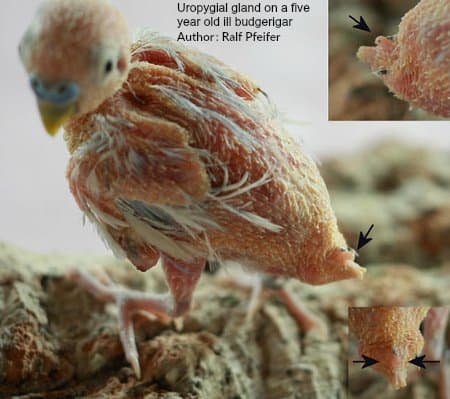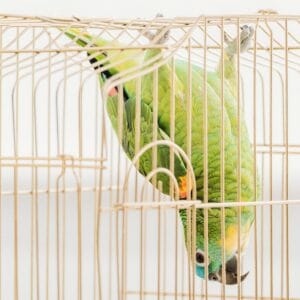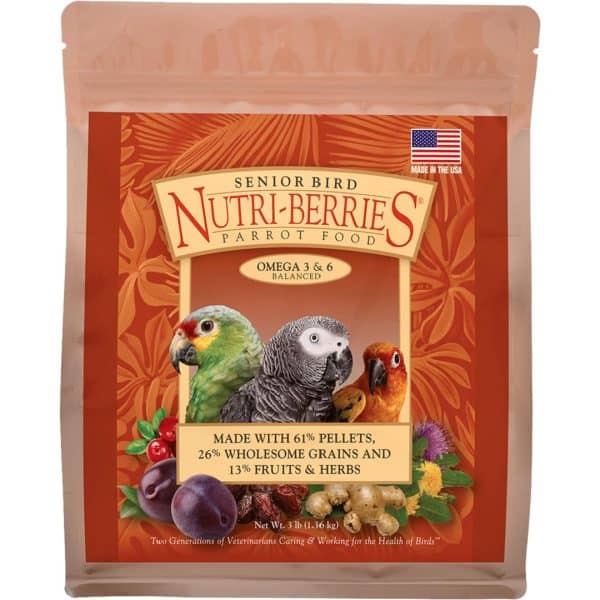Last Updated on by Mitch Rezman
How do Amazon parrots use light to synthesize Vitamin D having no preening gland?
As I was curating this post on Amazon parrot questions it got me thinking about one of my favorite subjects, full spectrum lighting and the synthesis of vitamin D in birds.
Amazon parrots are relatively unique having no preening gland (along with doves, pigeons and Hyacinth macaws).
The uropygial aka preening gland oozes a slippery goo which a bird rubs its head and beak against. Then spreads this oil over its feathered body.
This oil must find the bird skin under the feathers in order to begin the process of vitamin D synthesis.
So how do doves, pigeons, Hyacinth macaws and Amazon parrots syntesize vitamin D (which aids in the absorption of calcium)?
Nutrition my friends, nutrition. What they eat. A good pelleted diet will meet the basic nutritional needs of most captive birds. A seed diet may require additional supplementation.
If at-the-end-of-the-day in the absence of preening oil to be absorbed through the skin of an Amazon parrot no amount of light is going to act as a catalyst to a process that can’t exist – without the oil.

This begs the question as to why does Windy City Parrot offer the largest supply of lighting for birds on the Internet?
Two reasons one, many of our lights actually warm birds without light to help them sleep at night.
Two, more importantly to help keep their circadian rhythms synchronized with their instinctual expectations. More about that here.
Next question about Amazon Parrots
Hi
Enjoy your Sunday email and look forward to them. I’m not sure if you give out free advice, but thought I’d ask. I recently acquired a 33 year old Double Yellow Amazon.
I am his 4th owner, the latest owner was no longer able to take care of him. He is very cage possessive and can not be handled.
Any idea how to help him trust me? He’s in the main living area so we spend a lot of time together.
I’d like to get him eating fresh fruits and veggies. He looks at me and the food like I’m trying to poison him. I did have an African Parrot 15+ years ago so have some experience with large birds.
Thanks for listening. 🙂 Keep up the good work.
Ava F.
Thank you for the kind words Ava
Thank you for the kind words – For starters please watch the video in this product listing for $2 training clickers
I would advocate that you obtain some millet sprays – you can offer these through the cage or as you get close to the bird if he or she allows it to benefit is – these are tasty your bird will probably like them in the sprig keeps your hand 6 inches from the bird beak.
If he doesn’t care for millet, find a favorite treat like an unshelled sunflower kernel, a raisin or unshelled unsalted peanuts.
Drop them in his food dish every time you go by the cage to find out what he really likes and then when you offer a treat, place it in a food bowl so to its beak doesn’t have to interact with your fingers.
Once he responds to not aggressively receiving treats from you we can move forward.
mitchr
Hi
We’ve had Olive, our yellow-naped amazon, since she was 8 months old. She’s now 11 years old. She/he, spends most of her/his day outside her/his cage.
However, lately, she’s/he’s been getting down and walking around the house. We never know where she’ll/he’ll end up. Fortunately, Someone is home with her/him all day.
Would she/he benefit by getting another bird? If so, would she/he be ok with a cockatoo?
Thank you for your time!!
Joyce
Dear Joyce
Mitch would like to respond to you in-depth but he is busy right now.
I will try to get it rolling.
- Get your bird sexed. This behavior may be related to a female seeking out a place to build a nest.
- Please get a bird play stand or two. Having the bird out and about on the floor all the time is not safe.
If someone is not watching and the bird gets into something, destroys a treasured family album, chews an electrical cord, etc. Not good for bird or human.
- Getting a second bird will only double your work, will take away from your special time with your bird, or worse, they will hate each other.
Please look into the top two for starts.
“Olive” is only out of the cage when she can be supervised. She is covered at night as well.
I refer to her as a girl, as that is what we were told when we bought her at a pet shop. A veterinarian told me recently she is probably not female, or she would have laid by now, seeing as she is 11 years old.
Dear Joyce
Considering that Amazons do live a very long time, their reproductive cycle is not even slightly over at 11.
If conditions were not right for her previously, they may be now.
Editor’s note: The vet was not an avian vet. Birds can lose eggs in folds of body fat so not seeing an egg is no confirmation of sex type.
Yes Catherine, its difficult to break the habit of referring to her as a female after all these years.
Again, thank you for taking time to respond!
Joyce
Enjoy Your Journey!
Hello,
We live in southern TX, and would like to take our Amazon outside since the weather is so nice this time of year.
I will purchase a cage of course, but my concerns are what types of bugs and disease am I potentially going to expose her to? She will also be in a covered patio. How do I keep her safe?
Thank You,
Joyce
Hi Joyce,
Thanks for your questions and your sincere concern for your Amazon’s safety.
I have had companion parrots for 30+ years and for 7 years had an outdoor breeder aviary.
I currently happily share my life with a single Timneh African Grey, Timmy, who is a rescue from a bad home but tame and loving even after what he has been through (including being batted against a wall, losing consciousness).
I do clip wings slightly to prevent upward flight, unlike Mitch and Catherine.
But that is a personal choice and I love to hear of flighted birds. So I am not truly an advocate of clipping, it’s just best in my situation.
I live on the east coast of Central Florida, just south of Kennedy Space Center and only 4 blocks from the ocean.
This area is sub-tropical, just as your weather is right now in Texas. We also have summers much like yours (hot, hot, hot and often dry), though you probably have colder winters than we do.
The only concerns you should have about your bird outdoors as long as it is safely caged or in a harness or flight suit is it consuming standing water or any grasses that could have been sprayed with pesticides and the ambient temperature.
Cool strong breezes can cause respiratory infections or “colds”. Overheating can kill quickly if not recognized and controlled. Consuming or chewing on items that may not be bird safe such as metals, pressure treated wood, and similar items could cause poisoning that could kill the bird.
While we humans are plagued by concerns such as West Nile Virus, Zika Virus, Malaria and other maladies due to insect bites from mosquitoes and are plagued by other stinging insects, my research and personal experience have revealed no diseases transmitted to parrots via bug bites.
Consider this: our parrots evolved to live in pest-infested jungles with insects we’ve never encountered, yet they remain healthy.
On good weather days, my Timmy and I go outside in the unfiltered sunlight for at least 20 minutes to help both our bodies produce needed Vitamin D naturally. It also helps us absorb the vitamins we consume in food.
While I get bug bites if I do not protect against it, Timmy never is bothered.
Perhaps it is the way parrot feathers create a tight, thick layer of protection between the environment and their skin so that biting pests can’t penetrate the feathers.
The only pest I am aware of that you should worry about is mites. The only way your Amazon would get these is if you allowed him to play extensively in outdoor trees where these pests live.
Wild birds live with them but you don’t want to bring them inside your house as they do cause itching in birds. This is why you should wash and bake at low temperature for 20-30 minutes any branches brought indoors for perches. This ensures any mites present are killed.
When outdoors, use the temperature rule that if you are hot and perspiring, the bird is also getting too hot, and if you feel chilly, so does your bird.
Also, during hot weather if the bird opens its beak as if panting, go into a cool area or spray water on the bird because that is a sign of overheating which can kill quickly. Parrots have no sweat glands to control body temperature.
When you are outdoors, you experience pests, so I’d like to refer you to a blog post about bird-safe insect repellents, Mitch and Catherine use these and so do I, they are all natural and keep pests away from you and the parrot.
Visit 6 Bird Safe All Natural Home Made Mosquito Repellants……. I know you will find it useful. You can make a batch and use it for the rest of the season. It has been bird-tested with Mitch and Catherine’s birds and mine.The repellents really do work well and are safe with the single exception that you might have an allergy to an ingredient.
To test for that, drop one drop of the oil on a cotton ball and quickly touch it to your skin. If no reaction appears (redness, itching, burning, discomfort of any kind) then you are not allergic to the ingredients. Most people are not allergic to any of the ingredients but there are rare exceptions.
If you read the ingredients and the essential oil is made from a plant or flower you know you are allergic to, then you are allergic to the essential oil. If that is the case, choose one of the mixtures that do not contain that specific ingredient or simply leave it out of the mixture.
For indoor pest control, I recommend Mango Pest Control Aviary Bug Spray for general pest control and if you have any concerns regarding mites, use Mango DynaMyte Mite/Lice Pest Control.
Both products are totally bird safe and very effective. You might even want to spray around the cage outside with these products. Do allow them to dry before permitting your bird to enter the area and, of course, do not spray directly on the bird.
They have residual effects for up to one week if the area remains dry, although outdoors it might be less, especially if rain gets the area wet. But they dry quickly so it is not a long wait to spray again around the outdoor cage after dampness or rain.
I hope these helps. If you have further questions or concerns, please contact me.
Curated and edited by the Windy City Parrot Content Team
Your Zygodactyl Footnote
Author Profile
Latest entries
 The Traveling BirdJune 26, 2025Can You Name 5 Parrot Species That Are Living Wild in the USA?
The Traveling BirdJune 26, 2025Can You Name 5 Parrot Species That Are Living Wild in the USA? Bird BehaviorJune 26, 2025How is it Parrots Are Problem Solvers Social Animals and Even Use Tools?
Bird BehaviorJune 26, 2025How is it Parrots Are Problem Solvers Social Animals and Even Use Tools? Bird & Parrot AnatomyJune 25, 2025How a Tiny Chemical Modification Makes Parrots Nature’s Living Paintings
Bird & Parrot AnatomyJune 25, 2025How a Tiny Chemical Modification Makes Parrots Nature’s Living Paintings PigeonsJune 20, 2025How Do Parrots Thrive in Cities Outside Their Native Habitats?
PigeonsJune 20, 2025How Do Parrots Thrive in Cities Outside Their Native Habitats?




